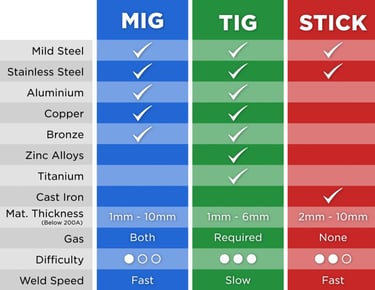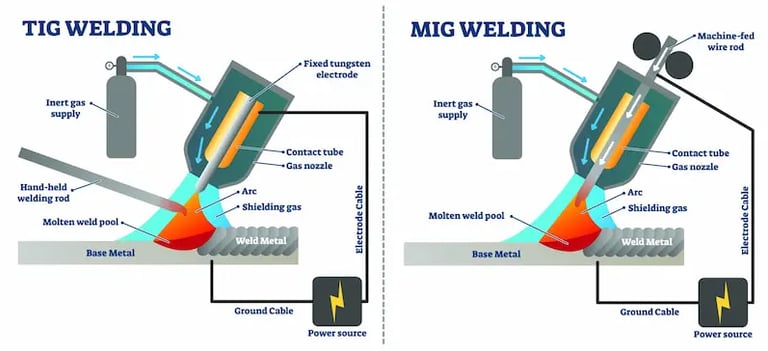A Guide to Welding Techniques: Which Is Best for Your Project?
Explore the various types of welding, including MIG, TIG, Stick, and Flux-Cored, and learn how to choose the best technique for your project. Whether you're tackling repairs, custom builds, or large-scale construction, this guide breaks down each method's pros and cons, helping you make informed decisions. Perfect for anyone looking to understand welding options and achieve long-lasting results.
Understanding Welding Types
Welding is a critical process in metal fabrication, essential in various industries, from automotive to construction. Several welding techniques exist, each suited to specific applications, materials, and skill levels. Among the most common methods are MIG (Metal Inert Gas), TIG (Tungsten Inert Gas), Stick, and Flux-Cored welding. Understanding these types is fundamental for selecting the best method for your project.
MIG welding, also known as Gas Metal Arc Welding (GMAW), utilizes a continuous solid wire electrode and an inert shielding gas to protect the weld pool from contamination. This technique is favored for its speed and versatility, making it suitable for welding thin to medium thickness metals such as aluminum, stainless steel, and mild steel. It is often employed in industries like automotive manufacturing, where efficiency and clean welds are paramount.
TIG welding, or Gas Tungsten Arc Welding (GTAW), employs a non-consumable tungsten electrode to create the weld. Filler material may be added if necessary, and an inert gas is used to shield the weld area. TIG welding provides excellent control and produces high-quality, precise welds, making it ideal for thin sections and applications that require strong, aesthetic finishes. This method is predominantly used for stainless steel and non-ferrous materials.
Stick welding, also referred to as Shielded Metal Arc Welding (SMAW), uses a consumable electrode coated in flux to create the weld. This process is relatively simple and requires minimal equipment, which enhances its popularity, especially in outdoor applications and in environments with wind. Stick welding is effective for joining steels and iron and is commonly used in construction and repair work.
Flux-Cored welding is similar to MIG welding but uses a tubular wire filled with flux. This technique can be performed with or without a shielding gas, allowing for effective welds in windy conditions. Flux-Cored is particularly useful for thicker materials and is widely applied in the construction industry as well.
Pros and Cons of MIG, TIG, Stick, and Flux-Cored Welding
Welding techniques vary significantly, each offering a unique set of advantages and disadvantages suitable for various projects and skill levels. Understanding these pros and cons will guide you in selecting the best welding method for your specific requirements.
PRO: MIG (Metal Inert Gas) welding is often praised for its ease of use, making it an ideal choice for beginners. This technique requires minimal training and operates at high speeds, allowing for efficient, continuous feed of wire. The resulting welds are usually clean with excellent penetration.
CON: However, MIG welding is less effective in windy conditions and generally requires more expensive equipment, including an inert gas supply.
PRO: TIG (Tungsten Inert Gas) welding is renowned for delivering high-quality welds on thin materials. It allows for exceptional control, enabling the welder to manipulate the weld pool with precision. TIG is versatile, suitable for welding a variety of metals, including aluminum and stainless steel.
CON: Unfortunately, it demands more skill and patience than MIG welding, which may pose a challenge for novices. Additionally, the process can be time-consuming due to the lack of filler rod feeding.
PRO: Stick (Shielded Metal Arc) welding is an established method known for its ability to weld in a wide range of environments, including outdoors and in adverse weather conditions. It is cost-effective since the equipment and consumables are generally less expensive.
CON: However, the quality of welds may not meet the same standards as MIG or TIG, requiring more clean-up and finishing work.
PRO: Flux-cored welding shares similarities with MIG but involves a tubular wire filled with flux. This technique is particularly effective for welding thick materials and is often used in construction.
CON: While it can be easier to use outdoors, the generated smoke and spatter may require additional post-weld cleanup, and the cost of flux-cored wires can add up.
In conclusion, each welding method has its distinctive characteristics, benefits, and limitations. The choice depends on your project's specific needs, budget, and your expertise level in using each technique. Evaluating these aspects will help streamline your decision-making process.
Choosing the Right Welding Technique for Your Project
Selecting the appropriate welding technique is crucial for ensuring successful outcomes in various projects. There are multiple welding methods available, each suited for specific applications and materials. Understanding the nature of your project, including factors such as material type, project size, cost considerations, and the desired quality of the weld, is essential for making an informed decision.
Firstly, the type of material you intend to weld plays a significant role in your choice of welding technique. Common materials such as steel, aluminum, or stainless steel possess unique properties that influence the effectiveness of different welding methods. For instance, TIG (Tungsten Inert Gas) welding is preferable for aluminum due to its ability to produce high-quality, precise welds, while MIG (Metal Inert Gas) welding is often chosen for its speed and efficiency when working with steel. Understanding material characteristics ensures compatibility and enhances the chances of achieving the desired weld quality.
Another critical consideration is the scale of your project. Smaller-scale repairs or custom builds can benefit from more versatile techniques like stick welding, which is ideal for novice welders and is suitable for various environments. Conversely, large-scale constructions often require more advanced methods such as MIG or TIG welding, which can provide greater strength and longevity to the welds. Cost is also a factor; while some techniques may have higher initial equipment costs, they can lead to cost savings over time due to reduced labor or material waste.
Ultimately, ensuring that your chosen welding technique aligns with your project's goals entails careful evaluation of these factors. By analyzing the specific requirements of your project, you can select the welding method that will yield the best results, ensuring both project success and adherence to quality standards.
Tips for Successful Welding - Best Practices and Techniques
Welding is a skill that combines art and science, demanding attention to detail for successful execution. One of the foremost tips for effective welding is to prioritize safety. Always wear appropriate personal protective equipment (PPE), such as welding helmets, gloves, and flame-resistant clothing. This protective gear is essential in preventing exposure to harmful ultraviolet light, sparks, and molten metal, which can lead to serious injuries. In addition, ensure that your workspace is well-ventilated to manage harmful fumes produced during welding processes.
Secondly, the maintenance of welding equipment plays a critical role in achieving optimal results. Regularly inspect your welding machine, torch, cables, and other accessories for wear and tear. Clear any debris or buildup on the equipment, as this can adversely affect the quality of the weld. Keeping your tools clean and well-maintained not only improves performance but also extends the lifespan of your equipment.
Another essential practice is thorough preparation before commencing a welding project. Ensure that the metals you are about to weld are clean, free from rust, oil, and dirt. Utilizing wire brushes or grinders can significantly enhance the quality of the weld by providing a clean surface. Conversely, neglecting preparation may result in weak bonds that could undermine the integrity of your work.
Moreover, take the time to set suitable parameters, such as voltage and amperage, appropriate for the chosen welding technique and materials. Properly adjusting these settings can make a significant difference in the quality of the weld. Lastly, practice patience and precision throughout the welding process; taking your time can lead to superior outcomes, while rushing can result in errors. By integrating these best practices into your welding routine, you can significantly improve the quality and durability of your projects.


Jstarr Fabrication LLC
Metal Fabrication Shop







